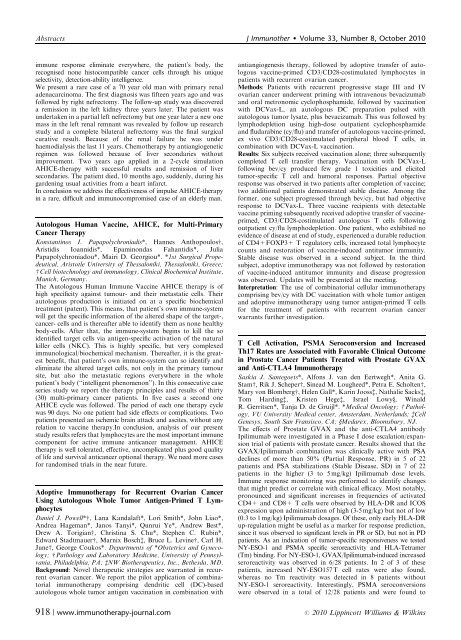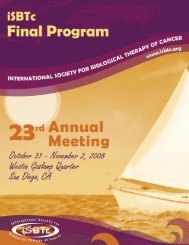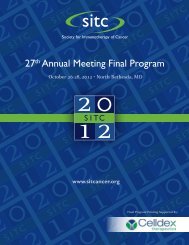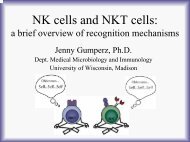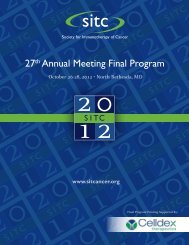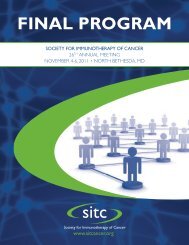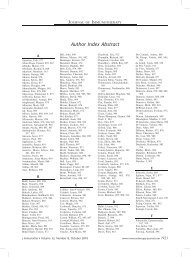Abstracts for the 25th Annual Scientific Meeting of the International ...
Abstracts for the 25th Annual Scientific Meeting of the International ...
Abstracts for the 25th Annual Scientific Meeting of the International ...
Create successful ePaper yourself
Turn your PDF publications into a flip-book with our unique Google optimized e-Paper software.
<strong>Abstracts</strong> J Immuno<strong>the</strong>r Volume 33, Number 8, October 2010<br />
immune response eliminate everywhere, <strong>the</strong> patient’s body, <strong>the</strong><br />
recognised none histocompatible cancer cells through his unique<br />
selectivity, detection-ability intelligence.<br />
We present a rare case <strong>of</strong> a 70 year old man with primary renal<br />
adenacarcinoma. The first diagnosis was fifteen years ago and was<br />
followed by right nefrectomy. The follow-up study was discovered<br />
a remission in <strong>the</strong> left kidney three years later. The patient was<br />
undertaken in a partial left nefrectomy but one year later a new one<br />
mass in <strong>the</strong> left renal remnant was revealed by follow up research<br />
study and a complete bilateral nefrectomy was <strong>the</strong> final surgical<br />
curative result. Because <strong>of</strong> <strong>the</strong> renal failure he was under<br />
haemodialysis <strong>the</strong> last 11 years. Chemo<strong>the</strong>rapy by antiangiogenetic<br />
regimen was followed because <strong>of</strong> liver secondaries without<br />
improvement. Two years ago applied in a 2-cycle simulation<br />
AHICE-<strong>the</strong>rapy with successful results and remission <strong>of</strong> liver<br />
secondaries. The patient died, 10 months ago, suddenly, during his<br />
gardening usual activities from a heart infarct.<br />
In conclusion we address <strong>the</strong> effectiveness <strong>of</strong> impulse AHICE-<strong>the</strong>rapy<br />
in a rare, difficult and immunocompromised case <strong>of</strong> an elderly man.<br />
Autologous Human Vaccine, AHICE, <strong>for</strong> Multi-Primary<br />
Cancer Therapy<br />
Konstantinos I. Papapolychroniadis*, Hannes Anthopoulosw,<br />
Aristidis Ioannidis*, Epaminondas Fahantidis*, Julia<br />
Papapolychroniadou*, Mairi D. Georgiou*. *1st Surgical Propedeutical,<br />
Aristotle University <strong>of</strong> Thessaloniki, Thessaloniki, Greece;<br />
w Cell biotechnology and immunology, Clinical Biochemical Institute,<br />
Munich, Germany.<br />
The Autologous Human Immune Vaccine AHICE <strong>the</strong>rapy is <strong>of</strong><br />
high specificity against tumour- and <strong>the</strong>ir metastatic cells. Their<br />
autologous production is initiated on at a specific biochemical<br />
treatment (patent). This means, that patient’s own immune-system<br />
will get <strong>the</strong> specific in<strong>for</strong>mation <strong>of</strong> <strong>the</strong> altered shape <strong>of</strong> <strong>the</strong> target-,<br />
cancer- cells and is <strong>the</strong>reafter able to identify <strong>the</strong>m as none healthy<br />
body-cells. After that, <strong>the</strong> immune-system begins to kill <strong>the</strong> so<br />
identified target cells via antigen-specific activation <strong>of</strong> <strong>the</strong> natural<br />
killer cells (NKC). This is highly specific, but very complexed<br />
immunological/biochemical mechanism. Thereafter, it is <strong>the</strong> greatest<br />
benefit, that patient’s own immune-system can so identify and<br />
eliminate <strong>the</strong> altered target cells, not only in <strong>the</strong> primary tumour<br />
site, but also <strong>the</strong> metastatic regions everywhere in <strong>the</strong> whole<br />
patient’s body (‘‘intelligent phenomenon’’). In this consecutive case<br />
series study we report <strong>the</strong> <strong>the</strong>rapy principles and results <strong>of</strong> thirty<br />
(30) multi-primary cancer patients. In five cases a second one<br />
AHICE cycle was followed. The period <strong>of</strong> each one <strong>the</strong>rapy cycle<br />
was 90 days. No one patient had side effects or complications. Two<br />
patients presented an ischemic brain attack and ascites, without any<br />
relation to vaccine <strong>the</strong>rapy.In conclusion, analysis <strong>of</strong> our present<br />
study results refers that lymphocytes are <strong>the</strong> most important immune<br />
component <strong>for</strong> active immune anticancer management. AHICE<br />
<strong>the</strong>rapy is well tolerated, effective, uncomplicated plus good quality<br />
<strong>of</strong> life and survival anticancer optional <strong>the</strong>rapy. We need more cases<br />
<strong>for</strong> randomised trials in <strong>the</strong> near future.<br />
Adoptive Immuno<strong>the</strong>rapy <strong>for</strong> Recurrent Ovarian Cancer<br />
Using Autologous Whole Tumor Antigen-Primed T Lymphocytes<br />
Daniel J. Powell*w, Lana Kandalaft*, Lori Smith*, John Liao*,<br />
Andrea Hageman*, Janos Tanyi*, Qunrui Ye*, Andrew Best*,<br />
Drew A. Torigianw, Christina S. Chu*, Stephen C. Rubin*,<br />
Edward Stadtmauerw, Marnix Boschz, Bruce L. Levinew, Carl H.<br />
Junew, George Coukos*. Departments <strong>of</strong> *Obstetrics and Gynecology;<br />
w Pathology and Laboratory Medicine, University <strong>of</strong> Pennsylvania,<br />
Philadelphia, PA; zNW Bio<strong>the</strong>rapeutics, Inc., Be<strong>the</strong>sda, MD.<br />
Background: Novel <strong>the</strong>rapeutic strategies are warranted in recurrent<br />
ovarian cancer. We report <strong>the</strong> pilot application <strong>of</strong> combinatorial<br />
immuno<strong>the</strong>rapy comprising dendritic cell (DC)-based<br />
autologous whole tumor antigen vaccination in combination with<br />
antiangiogenesis <strong>the</strong>rapy, followed by adoptive transfer <strong>of</strong> autologous<br />
vaccine-primed CD3/CD28-costimulated lymphocytes in<br />
patients with recurrent ovarian cancer.<br />
Methods: Patients with recurrent progressive stage III and IV<br />
ovarian cancer underwent priming with intravenous bevacizumab<br />
and oral metronomic cyclophosphamide, followed by vaccination<br />
with DCVax-L, an autologous DC preparation pulsed with<br />
autologous tumor lysate, plus bevacizumab. This was followed by<br />
lymphodepletion using high-dose outpatient cyclophosphamide<br />
and fludarabine (cy/flu) and transfer <strong>of</strong> autologous vaccine-primed,<br />
ex vivo CD3/CD28-costimulated peripheral blood T cells, in<br />
combination with DCVax-L vaccination.<br />
Results: Six subjects received vaccination alone; three subsequently<br />
completed T cell transfer <strong>the</strong>rapy. Vaccination with DCVax-L<br />
following bev/cy produced few grade 1 toxicities and elicited<br />
tumor-specific T cell and humoral responses. Partial objective<br />
response was observed in two patients after completion <strong>of</strong> vaccine;<br />
two additional patients demonstrated stable disease. Among <strong>the</strong><br />
<strong>for</strong>mer, one subject progressed through bev/cy, but had objective<br />
response to DCVax-L. Three vaccine recipients with detectable<br />
vaccine priming subsequently received adoptive transfer <strong>of</strong> vaccineprimed,<br />
CD3/CD28-costimulated autologous T cells following<br />
outpatient cy/flu lymphodepletion. One patient, who exhibited no<br />
evidence <strong>of</strong> disease at end <strong>of</strong> study, experienced a durable reduction<br />
<strong>of</strong> CD4+FOXP3+ T regulatory cells, increased total lymphocyte<br />
counts and restoration <strong>of</strong> vaccine-induced antitumor immunity.<br />
Stable disease was observed in a second subject. In <strong>the</strong> third<br />
subject, adoptive immuno<strong>the</strong>rapy was not followed by restoration<br />
<strong>of</strong> vaccine-induced antitumor immunity and disease progression<br />
was observed. Updates will be presented at <strong>the</strong> meeting.<br />
Interpretation: The use <strong>of</strong> combinatorial cellular immuno<strong>the</strong>rapy<br />
comprising bev/cy with DC vaccination with whole tumor antigen<br />
and adoptive immuno<strong>the</strong>rapy using tumor antigen-primed T cells<br />
<strong>for</strong> <strong>the</strong> treatment <strong>of</strong> patients with recurrent ovarian cancer<br />
warrants fur<strong>the</strong>r investigation.<br />
T Cell Activation, PSMA Seroconversion and Increased<br />
Th17 Rates are Associated with Favorable Clinical Outcome<br />
in Prostate Cancer Patients Treated with Prostate GVAX<br />
and Anti-CTLA4 Immuno<strong>the</strong>rapy<br />
Saskia J. Santegoets*, Alfons J. van den Eertwegh*, Anita G.<br />
Stamw, Rik J. Scheperw, Sinead M. Lougheed*, Petra E. Scholtenw,<br />
Mary von Blombergw, Helen Gall*, Karin Joossz, Nathalie Sacksz,<br />
Tom Hardingz, Kristen Hegez, Israel Lowyy, Winald<br />
R. Gerritsen*, Tanja D. de Gruijl*. *Medical Oncology; w Pathology,<br />
VU University Medical center, Amsterdam, Ne<strong>the</strong>rlands; zCell<br />
Genesys, South San Fransisco, CA; yMedarex, Bloomsbury, NJ.<br />
The effects <strong>of</strong> Prostate GVAX and <strong>the</strong> anti-CTLA4 antibody<br />
Ipilimumab were investigated in a Phase I dose escalation/expansion<br />
trial <strong>of</strong> patients with prostate cancer. Results showed that <strong>the</strong><br />
GVAX/Ipilimumab combination was clinically active with PSA<br />
declines <strong>of</strong> more than 50% (Partial Response, PR) in 5 <strong>of</strong> 22<br />
patients and PSA stabilizations (Stable Disease, SD) in 7 <strong>of</strong> 22<br />
patients in <strong>the</strong> higher (3 to 5 mg/kg) Ipilimumab dose levels.<br />
Immune response monitoring was per<strong>for</strong>med to identify changes<br />
that might predict or correlate with clinical efficacy. Most notably,<br />
pronounced and significant increases in frequencies <strong>of</strong> activated<br />
CD4+ and CD8+ T cells were observed by HLA-DR and ICOS<br />
expression upon administration <strong>of</strong> high (3-5 mg/kg) but not <strong>of</strong> low<br />
(0.3 to 1 mg/kg) Ipilimumab dosages. Of <strong>the</strong>se, only early HLA-DR<br />
up-regulation might be useful as a marker <strong>for</strong> response prediction,<br />
since it was observed to significant levels in PR or SD, but not in PD<br />
patients. As an indication <strong>of</strong> tumor-specific responsiveness we tested<br />
NY-ESO-1 and PSMA specific seroreactivity and HLA-Tetramer<br />
(Tm) binding. For NY-ESO-1, GVAX/Ipilimumab-induced increased<br />
seroreactivity was observed in 6/28 patients. In 2 <strong>of</strong> 3 <strong>of</strong> <strong>the</strong>se<br />
patients, increased NY-ESO157 T cell rates were also found,<br />
whereas no Tm reactivity was detected in 8 patients without<br />
NY-ESO-1 seroreactivity. Interestingly, PSMA seroconversions<br />
were observed in a total <strong>of</strong> 12/28 patients and were found to<br />
918 | www.immuno<strong>the</strong>rapy-journal.com r 2010 Lippincott Williams & Wilkins


